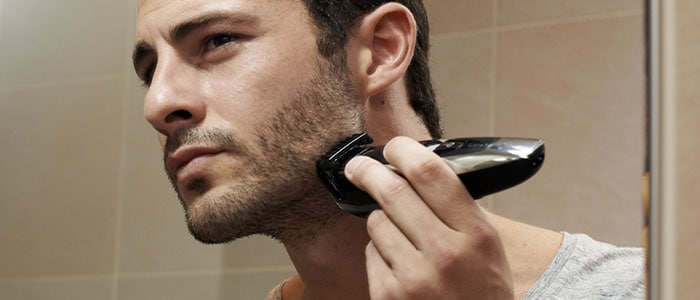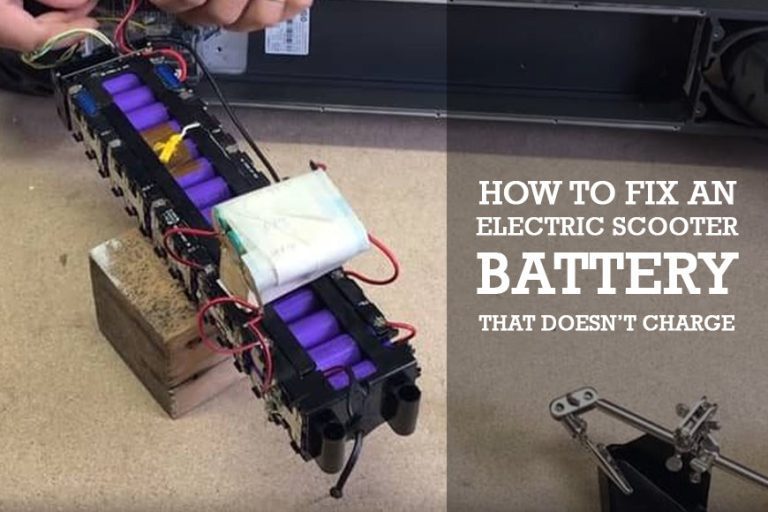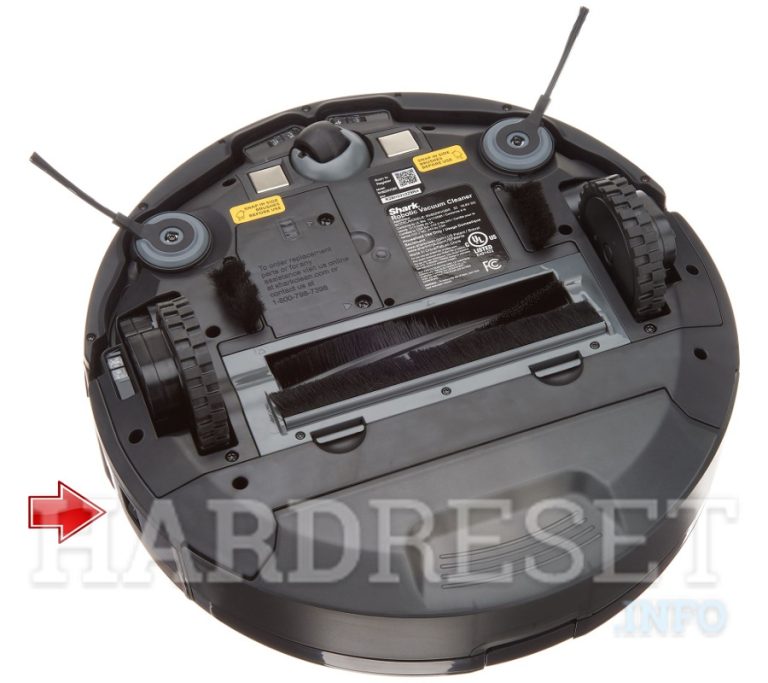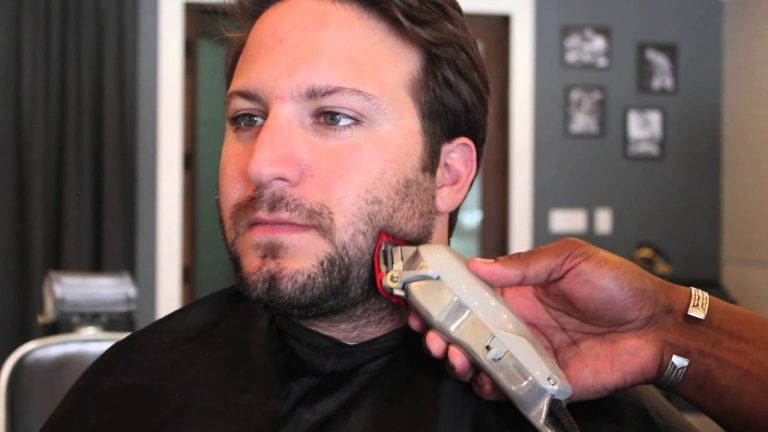How to Trim a Beard With a Beard Trimmer?

To trim a beard with a beard trimmer, start by selecting the desired length, adjusting the trimmer accordingly, and then carefully trimming the beard in the direction of hair growth to achieve a neat and well-groomed look. Trimming a beard with a beard trimmer can help maintain a tidy appearance while allowing for customized length options.
Whether you’re looking to shape a full beard or maintain a stubble look, using a beard trimmer can be a simple and efficient way to achieve your desired style. By following a few basic steps, it’s easy to trim your beard with a beard trimmer and keep it looking sharp.
Choosing The Right Beard Trimmer
When it comes to maintaining a well-groomed beard, choosing the right beard trimmer is essential. With the plethora of options available in the market, it can be overwhelming to determine which one will best suit your needs. In this section, we will guide you through the factors to consider when selecting a beard trimmer, helping you make an informed decision.
Consider your beard length and type
Before diving into the features and specifications of a beard trimmer, it is crucial to consider your beard length and type. Every beard is unique, and different trimmers cater to different lengths and styles. Whether you prefer a short, stubble beard or a long, full beard, it’s essential to choose a trimmer that can handle your specific needs.
Look for adjustable length settings
One of the essential features to look for in a beard trimmer is the availability of adjustable length settings. This allows you to customize the length of your beard according to your desired style. With an adjustable trimmer, you can experiment with different beard lengths and easily switch between various grooming styles, giving you the flexibility to keep up with changing trends.
Check for cordless or corded options
When it comes to convenience, the choice between a cordless or corded beard trimmer is crucial. Cordless trimmers offer the advantage of portability and freedom of movement, allowing you to trim your beard anywhere without being restricted by a power cord. On the other hand, corded trimmers ensure a constant power source, eliminating the need to worry about battery life during longer grooming sessions. Consider your usage preferences and grooming routine to decide which option suits you best.

Credit: www.usa.philips.com
Preparing Your Beard For Trimming
Before you start trimming your beard, it’s important to prepare your facial hair properly. This will not only make the trimming process easier and more precise but also ensure that your beard looks its best afterward. Here are three essential steps to follow when preparing your beard for trimming: washing, combing, and applying beard oil or conditioner.
Wash Your Beard Thoroughly
One of the first steps in preparing your beard for trimming is giving it a thorough wash. This will remove any dirt, debris, and excess oil that may have accumulated in your facial hair. To wash your beard properly:
- Start by wetting your beard with warm water. This will help to open up the hair follicles and make washing more effective.
- Apply a small amount of beard shampoo or a gentle facial cleanser specifically designed for beard care. Gently massage the product into your beard, working it into a lather. Pay special attention to the roots of your beard to ensure all areas are well-covered.
- Rinse your beard thoroughly with warm water until all shampoo or cleanser residue is removed. It’s crucial to ensure that no product remains in your beard, as this could cause irritation or dryness.
- Pat your beard dry with a clean towel. Avoid rubbing or pulling on the hair too vigorously, as this could lead to tangles or breakages.
Comb Your Beard to Remove Tangles
After washing, it’s essential to comb your beard to remove any tangles or knots. This step will help to make the trimming process smoother and prevent uneven cuts. Follow these steps to comb your beard effectively:
- Start by using a quality beard comb or brush with wide teeth. This will help to detangle your beard without causing any unnecessary pulling or discomfort.
- Gently comb through your beard, starting from the roots and working your way down to the ends. Take your time and ensure that you comb through all areas, including the mustache and sideburns.
- If you encounter any stubborn knots or tangles, avoid yanking on them forcefully. Instead, use your fingers or the comb to gently tease them apart.
Apply a Beard Oil or Conditioner
Applying beard oil or conditioner is the final step in preparing your beard for trimming. This will help to soften the hair, moisturize the skin, and make the trimming process smoother. Follow these guidelines to apply beard oil or conditioner effectively:
- Choose a high-quality beard oil or conditioner that suits your preferences and skin type. Look for products that contain natural ingredients and are free from harsh chemicals.
- Dispense a small amount of the oil or conditioner into your palms and rub them together to distribute the product evenly.
- Massage the oil or conditioner into your beard, ensuring that it reaches the roots of your facial hair and the skin beneath. Make sure to cover all areas, including the mustache and sideburns.
- Once applied, use a beard comb or brush to distribute the product even further and ensure it reaches all strands of hair.
By following these steps, you will have properly prepared your beard for trimming. This will result in a smoother trimming experience and a beard that looks neat, well-groomed, and healthy.
Trimming Techniques For Different Beard Styles
When it comes to trimming your beard with a beard trimmer, it’s important to understand the techniques for different beard styles. Whether you have a short and stubble beard, a full beard, or a goatee, knowing the right methods can help you achieve a well-groomed look. Let’s dive into the specific techniques you need to master for each beard style.
Maintaining a short and stubble beard
To maintain a short and stubble beard, you want to achieve a consistent length all over your facial hair. Start by setting the beard trimmer to a low length, around 1-2mm, to give you that desired short length. Trim evenly across the entire beard using upward strokes. This will help remove any stray hairs and maintain a neat appearance. Remember to follow the natural contours of your face for a clean and symmetrical look.
Shaping a full beard
When shaping a full beard, it’s important to maintain its length while giving it a well-defined shape. Start by trimming the neckline and cheek line to create a distinct boundary for your beard. Use a comb as a guide for length, running it through your beard and trimming any hairs that extend beyond its teeth. This will help you achieve an even and symmetrical appearance.
Sculpting a goatee or mustache
A goatee or mustache requires precise trimming and shaping to achieve the desired look. Start by trimming the area around the lip carefully, removing any stray hairs that extend beyond your desired shape. Use the trimmer’s precision attachments or a smaller blade setting to achieve the necessary control. Take your time and define the shape with precision, ensuring clean lines and a polished finish.
Trimming the neckline and cheek line
Regardless of the beard style you choose, trimming the neckline and cheek line is crucial for a well-groomed appearance. Use the trimmer to create a defined neckline by following your natural jawline. Trim any hairs below this line to maintain a clean and tidy look. As for the cheek line, use a similar approach by following the natural contour of your cheek and trimming any stray hairs outside the desired boundary.
Fine-Tuning And Detailing
Once you have achieved the desired length for your beard, it’s time to move on to fine-tuning and detailing. This crucial step is what sets apart a well-groomed beard from a just “grown-out” one. By paying attention to small areas, trimming stray hairs, defining beard lines, and shaping and blending the beard, you can achieve a polished and sophisticated look. Let’s dive into the specifics of each aspect in detail.
Using a Precision Trimmer or Attachments for Small Areas
For those hard-to-reach or delicate areas, a precision trimmer or different attachments for your beard trimmer can come in handy. Whether it’s the area just under your nose, around your lips, or near your sideburns, these tools make it easier to maintain control and achieve precise results.
Pro Tip: When using a precision trimmer or an attachment, start with a higher length setting and gradually decrease it until you achieve the desired look. This allows for more control and prevents accidentally trimming too much hair.
Trimming Stray Hairs and Defining Beard Lines
Stray hairs can make even the neatest beard look unkempt. To keep them in check, carefully trim any stray hairs that are outside of your defined beard lines. Use your beard trimmer’s detail or edging attachment for greater precision. Take your time and go slow, making sure to follow the natural shape of your beard. This will help you maintain a clean and well-defined look.
Pro Tip: To make defining your beard lines easier, comb your beard in the direction of hair growth before trimming. This will create a more defined outline and make it easier to see which hairs need to be trimmed.
Shaping and Blending the Beard for a Polished Look
The final step in fine-tuning and detailing your beard is shaping and blending it for a polished and well-groomed appearance. Use your beard trimmer to shape the overall outline of your beard, ensuring that it complements your face shape. Pay attention to any uneven patches and trim them accordingly. For a seamless blend, switch to a lower length setting on your trimmer and gently fade the edges of your beard into your sideburns and neck area.
Pro Tip: When shaping and blending your beard, it’s essential to step back and take a few moments to assess your progress regularly. This allows you to make adjustments as needed and ensures a more balanced and symmetrical look.
By dedicating time and attention to fine-tuning and detailing your beard with a beard trimmer, you can achieve a polished and sophisticated look. Remember, patience and precision are key to crafting the perfect beard shape. So go ahead, grab your trimmer, and give your beard the attention it deserves!
Beard Trimming Tips And Maintenance
When it comes to maintaining your beard, proper trimming is essential. Not only does it help keep your beard looking neat and well-groomed, but it also promotes healthier beard growth. In this article, we will share some valuable tips on how to trim your beard effectively with a beard trimmer. By following these tips, you can achieve the desired length and shape while keeping your beard in top-notch condition.
Trim your beard when it’s dry
Trimming your beard when it’s dry is crucial for accuracy and precision. When your beard is wet, it tends to appear longer and can mislead you into over-trimming. To ensure precise results, always trim your beard when it is dry. This way, you can accurately assess the length and make the necessary adjustments in a well-lit area.
Start with a longer length and gradually go shorter
If you’re unsure about the ideal length of your trimmed beard, it’s always safer to start longer. You can gradually go shorter until you achieve the desired length. This incremental approach helps prevent any regrettable over-trimming mishaps. Remember, you can always trim more, but you can’t put the length back once it’s gone.
Start by using a longer guard setting on your beard trimmer and trim your beard evenly. Take your time and make small adjustments until you are satisfied with the length. Always use the appropriate guard attachment for even trimming and to avoid accidentally trimming too much.
Regularly clean and oil your beard trimmer for optimal performance
To ensure optimal performance of your beard trimmer, it’s essential to regularly clean and oil the device. Over time, hair clippings and debris can accumulate in the trimmer’s blades, leading to reduced performance and potential damage.
After each use, use a small brush or a toothbrush to remove hair and debris from the trimmer’s blades. You can also consider using a specialized trimmer cleaning solution to thoroughly clean the blades. Additionally, don’t forget to oil the trimmer regularly to keep the blades lubricated and functioning smoothly.
By following these simple beard trimming tips and maintenance practices, you can confidently use a beard trimmer to achieve a well-maintained and stylish beard. Remember, regular trimming and proper maintenance go hand in hand for a healthy and impressive beard.
Troubleshooting And Common Mistakes
While using a beard trimmer can make the process of trimming your beard much easier and convenient, it’s important to be aware of some common mistakes that can occur. By addressing these issues and troubleshooting any problems that arise, you can achieve a well-groomed and evenly trimmed beard.
Avoiding Uneven Trimming by Taking Your Time
One of the most common mistakes when using a beard trimmer is rushing through the trimming process, which can result in uneven lines or an inconsistent length. To avoid this, take your time and approach the trimming process with patience and precision.
Start by selecting the appropriate length setting on your beard trimmer. Begin with a longer setting and gradually work your way down until you achieve your desired length. By gradually reducing the length, you have more control and can avoid accidentally trimming too much off.
When trimming, use short, deliberate strokes in the direction of your beard growth. Avoid trying to trim large sections of your beard in one pass, as this can lead to uneven results. Instead, focus on small areas at a time, ensuring each section is trimmed evenly before moving on.
Dealing with Ingrown Hairs or Irritation
Ingrown hairs and irritation are common problems that can occur when trimming your beard. However, there are steps you can take to minimize these issues.
Prior to trimming, make sure your beard and skin are clean and dry. This helps to prevent dirt, oils, or dead skin cells from clogging your trimmer and leading to irritation. Consider using a beard wash or gentle cleanser to remove any buildup on your beard before trimming.
If you experience ingrown hairs, use a clean, sharp pair of tweezers to carefully lift the hair out, being cautious not to further irritate the skin. Applying a warm compress to the affected area can help to reduce inflammation and alleviate discomfort.
To prevent future ingrown hairs, consider exfoliating your skin regularly. This helps to remove dead skin cells and unclog hair follicles, allowing your beard to grow freely without becoming trapped beneath the surface.
Fixing Accidental Mistakes or Uneven Lines
Even with careful trimming, accidental mistakes or uneven lines can occur. Fortunately, there are methods you can employ to fix these issues and achieve a more polished look.
If you notice an accidental mistake or uneven line, resist the urge to immediately trim more hair off in an attempt to correct it. Doing so can exacerbate the problem and make it more difficult to fix.
Instead, try using a comb or beard brush to gently blend the area and smooth out any unevenness. If necessary, use a pair of small, sharp scissors to carefully trim away any stray hairs or adjust the line. Take your time and approach this process methodically to achieve the desired result.
Remember, practice makes perfect when it comes to beard trimming. The more you familiarize yourself with your trimmer and understand your beard’s growth patterns, the better your results will be. Don’t be discouraged by mistakes or unevenness, as they can often be easily corrected with a little patience and attention to detail.
Finalizing Your Beard Trim
Once you’ve mastered the art of using a beard trimmer to shape and style your facial hair, it’s time to finalize your beard trim. This step is crucial to ensure a clean and polished look. In this section, we will discuss two important steps to complete your beard grooming routine: cleaning up any remaining loose hairs and using beard products for styling and grooming.
Cleaning up any remaining loose hairs
After trimming your beard, it’s common to have some stray hairs left behind. Cleaning up these loose hairs will give your beard a neat and professional appearance. Here are some tips to help you get rid of those pesky strays:
- Inspect your beard: Take a close look at your beard in a well-lit area to identify any stray hairs that need to be cleaned up.
- Use a comb: Gently comb through your beard to separate the hairs and expose any hidden strays.
- Trim the remaining hairs: Grab your beard trimmer and set it to a lower setting. Carefully trim the remaining loose hairs, taking care not to trim too much and maintain the desired shape of your beard.
- Inspect again: After trimming, inspect your beard once more to ensure you haven’t missed any stray hairs.
Using beard products for styling and grooming
To add the finishing touches to your perfectly trimmed beard, it’s essential to use the right beard products. These products not only help with styling but also keep your beard healthy and well-groomed. Here are some essential beard products to consider:
| Top Beard Products | Benefits |
|---|---|
| Beard oil | Moisturizes the beard and skin, reduces itchiness, and adds shine. |
| Beard balm | Provides more hold for styling, tames flyaways, and conditions the beard. |
| Beard wax | Offers stronger hold for shaping, provides texture, and helps with styling. |
| Beard brush/comb | Helps distribute product evenly, detangles the beard, and styles the hairs. |
Choose the right beard products based on your needs and preferences. Apply the products according to the instructions on the packaging, focusing on the areas that need styling or conditioning.
Admiring your perfectly trimmed beard
Now that you have completed the final steps of cleaning up any stray hairs and utilizing beard products, take a moment to appreciate your well-groomed and perfectly trimmed beard. Run your fingers through your beard, feeling the softness and evenness of the hairs. Admire the clean lines and defined shape you have achieved.
Maintaining a well-groomed beard requires regular upkeep. Repeat the trimming and grooming routine whenever necessary to keep your beard looking its best. With the right tools, techniques, and a little bit of practice, you can easily achieve a perfectly trimmed beard that will make heads turn.
Frequently Asked Questions On How To Trim A Beard With A Beard Trimmer
How Do You Trim A Beard With A Trimmer For Beginners?
To trim a beard with a trimmer for beginners, follow these steps:
1. Start by washing and combing your beard to remove any tangles.
2. Select the desired length setting on the trimmer and begin trimming from the bottom, working your way up.
3. Use the trimmer in the direction of hair growth to achieve an even cut.
4. Make small, controlled movements and avoid pressing too hard to prevent any accidental cuts.
5. Regularly check the mirror to ensure you’re achieving the desired shape and length.
Do You Trim Up Or Down With A Beard Trimmer?
You can trim your beard up or down using a beard trimmer.
What Is The Correct Way To Hold A Beard Trimmer?
To hold a beard trimmer correctly, grip it firmly but not too tightly. Hold it with your dominant hand, making sure to have a secure and comfortable grasp. Position the trimmer at the desired angle and use gentle, controlled movements for precise trimming.
Where Should Your Beard Neckline Be?
The beard neckline should be just above the Adam’s apple to create a clean and defined look.
Conclusion
Mastering the art of beard trimming with a beard trimmer is all about precision and technique. Remember to start with a clean, dry beard and select the appropriate blade length for your desired style. Take your time, trim in the direction of hair growth, and use steady, controlled movements. Regular maintenance of your trimmer ensures optimal performance. With practice and our expert tips, you’ll achieve a well-groomed and stylish beard that enhances your overall look.



